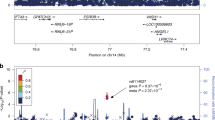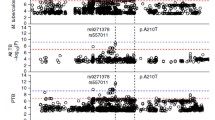Abstract
Tuberculosis (TB) has substantial mortality worldwide with 5–10% of those exposed progressing to active TB disease. Studies in mice and humans indicate that the inducible nitric oxide synthase (iNOS) molecule plays an important role in immune response to TB. A mixed case–control association study of individuals with TB, relatives, or close contact controls was performed in 726 individuals (279 case and 166 control African-Americans; 198 case and 123 control Caucasians). Thirty-nine single nucleotide polymorphisms (SNPs) were selected from the NOS2A gene for single SNP, haplotype, and multilocus interaction analyses with other typed candidate genes using generalized estimating equations. In African-Americans, ten NOS2A SNPs were associated with TB. The strongest associations were observed at rs2274894 (odds ratio (OR) = 1.84, 95% confidence interval (CI) [1.23–2.77], p = 0.003) and rs7215373 (OR = 1.67, 95% CI [1.17–2.37], p = 0.004), both of which passed a false discovery rate correction for multiple comparisons (q* = 0.20). The strongest gene–gene interactions were observed between NOS2A rs2248814 and IFNGR1 rs1327474 (p = 0.0004) and NOS2A rs944722 and IFNGR1 rs1327474 (p = 0.0006). Three other SNPs in NOS2A interacted with TLR4 rs5030729 and five other NOS2A SNPs interacted with IFNGR1 rs1327474. No significant associations were observed in Caucasians. These results suggest that NOS2A variants may contribute to TB susceptibility, particularly in individuals of African descent, and may act synergistically with SNPs in TLR4 and IFNGR1.

Similar content being viewed by others
References
Abel B, Thieblemont N, Quesniaux VJ, Brown N, Mpagi J, Miyake K, Bihl F, Ryffel B (2002) Toll-like receptor 4 expression is required to control chronic Mycobacterium tuberculosis infection in mice. J Immunol 169:3155–3162
Akinbami (2006) Asthma prevalence, health care use and mortality: United States, 2003–2005
Asensi V, Montes AH, Valle E, Ocana MG, Astudillo A, Alvarez V, Lopez-Anglada E, Solis A, Coto E, Meana A, Gonzalez P, Carton JA, Paz J, Fierer J, Celada A (2007) The NOS3 (27-bp repeat, intron 4) polymorphism is associated with susceptibility to osteomyelitis. Nitric Oxide 16:44–53
Barrett JC, Fry B, Maller J, Daly MJ (2005) Haploview: analysis and visualization of LD and haplotype maps. Bioinformatics 21:263–265
Berrington WR, Hawn TR (2007) Mycobacterium tuberculosis, macrophages, and the innate immune response: does common variation matter? Immunol Rev 219:167–186
Benjamini Y, Hochberg Y (1995) Controlling the false discovery rate: a practical and powerful approach to multiple testing. J R Stat Soci Ser B (Methodological) 57:289–300
Burgner D, Usen S, Rockett K, Jallow M, Ackerman H, Cervino A, Pinder M, Kwiatkowski DP (2003) Nucleotide and haplotypic diversity of the NOS2A promoter region and its relationship to cerebral malaria. Hum Genet 112:379–386
Caput D, Beutler B, Hartog K, Thayer R, Brown-Shimer S, Cerami A (1986) Identification of a common nucleotide sequence in the 3′-untranslated region of mRNA molecules specifying inflammatory mediators. Proc Natl Acad Sci USA 83:1670–1674
Center for Disease Control (CDC) (2004) Racial disparities in tuberculosis-selected southeastern states, 1991–2002. Morb Mortal Wkly Rep 53:556–559
Chan J, Xing Y, Magliozzo RS, Bloom BR (1992) Killing of virulent Mycobacterium tuberculosis by reactive nitrogen intermediates produced by activated murine macrophages. J Exp Med 175:1111–1122
Comstock G (1978) Tuberculosis in twins: a re-analysis of the Prophit survey. Am Rev Respir Dis 117:621–624
Cooke GS, Campbell SJ, Sillah J, Gustafson P, Bah B, Sirugo G, Bennett S, McAdam KP, Sow O, Lienhardt C, Hill AV (2006) Polymorphism within the interferon-gamma/receptor complex is associated with pulmonary tuberculosis. Am J Respir Crit Care Med 174:339–343
Cooper AM, Dalton DK, Stewart TA, Griffin JP, Russell DG, Orme IM (1993) Disseminated tuberculosis in interferon gamma gene-disrupted mice. J Exp Med 178:2243–2247
de Vera ME, Shapiro RA, Nussler AK, Mudgett JS, Simmons RL, Morris SM Jr, Billiar TR, Geller DA (1996) Transcriptional regulation of human inducible nitric oxide synthase (NOS2) gene by cytokines: initial analysis of the human NOS2 promoter. Proc Natl Acad Sci USA 93:1054–1059
Dorman SE, Picard C, Lammas D, Heyne K, van Dissel JT, Baretto R, Rosenzweig SD, Newport M, Levin M, Roesler J, Kumararatne D, Casanova JL, Holland SM (2004) Clinical features of dominant and recessive interferon gamma receptor 1 deficiencies. Lancet 364:2113–2121
Flynn JL, Chan J (2001) Immunology of tuberculosis. Annu Rev Immunol 19:93–129
Flynn JL, Chan J, Triebold KJ, Dalton DK, Stewart TA, Bloom BR (1993) An essential role for interferon gamma in resistance to Mycobacterium tuberculosis infection. J Exp Med 178:2249–2254
Gabriel SB, Schaffner SF, Nguyen H, Moore JM, Roy J, Blumenstiel B, Higgins J, DeFelice M, Lochner A, Faggart M, Liu-Cordero SN, Rotimi C, Adeyemo A, Cooper R, Ward R, Lander ES, Daly MJ, Altshuler D (2002) The structure of haplotype blocks in the human genome. Science 296:2225–2229
Gibson CS, MacLennan AH, Dekker GA, Goldwater PN, Dambrosia JM, Munroe DJ, Tsang S, Stewart C, Nelson KB (2007) Genetic polymorphisms and spontaneous preterm birth. Obstet Gynecol 109:384–391
Gomez LM, Anaya JM, Vilchez JR, Cadena J, Hinojosa R, Velez L, Lopez-Nevot MA, Martin J (2007) A polymorphism in the inducible nitric oxide synthase gene is associated with tuberculosis. Tuberculosis (Edinb) 87:288–294
Hancock DB, Martin ER, Li YJ, Scott WK (2007) Methods for interaction analyses using family-based case–control data: conditional logistic regression versus generalized estimating equations. Genet Epidemiol 31:883–893
Hancock DB, Martin ER, Vance JM, Scott WK (2008) Nitric oxide synthase genes and their interactions with environmental factors in Parkinson’s disease. Neurogenetics 9:249–262
Hobbs MR, Udhayakumar V, Levesque MC, Booth J, Roberts JM, Tkachuk AN, Pole A, Coon H, Kariuki S, Nahlen BL, Mwaikambo ED, Lal AL, Granger DL, Anstey NM, Weinberg JB (2002) A new NOS2 promoter polymorphism associated with increased nitric oxide production and protection from severe malaria in Tanzanian and Kenyan children. Lancet 360:1468–1475
Hussain S, Zwilling BS, Lafuse WP (1999) Mycobacterium avium infection of mouse macrophages inhibits IFN-gamma Janus kinase-STAT signaling and gene induction by down-regulation of the IFN-gamma receptor. J Immunol 163:2041–2048
Jamieson SE, Miller EN, Black GF, Peacock CS, Cordell HJ, Howson JM, Shaw MA, Burgner D, Xu W, Lins-Lainson Z, Shaw JJ, Ramos F, Silveira F, Blackwell JM (2004) Evidence for a cluster of genes on chromosome 17q11–q21 controlling susceptibility to tuberculosis and leprosy in Brazilians. Genes Immun 5:46–57
Johannesen J, Pie A, Pociot F, Kristiansen OP, Karlsen AE, Nerup J (2001) Linkage of the human inducible nitric oxide synthase gene to type 1 diabetes. J Clin Endocrinol Metab 86:2792–2796
Juenger TE, Wayne T, Boles S, Symonds VV, McKay J, Coughlan SJ (2006) Natural genetic variation in whole-genome expression in Arabidopsis thaliana: the impact of physiological QTL introgression. Mol Ecol 15:1351–1365
Kamijo R, Gerecitano J, Shapiro D, Green SJ, Aguet M, Le J, Vilcek J (1995) Generation of nitric oxide and clearance of interferon-gamma after BCG infection are impaired in mice that lack the interferon-gamma receptor. J Inflamm 46:23–31
Kleinert H, Schwarz PM, Forstermann U (2003) Regulation of the expression of inducible nitric oxide synthase. Biol Chem 384:1343–1364
Kleinert H, Pautz A, Linker K, Schwarz PM (2004) Regulation of the expression of inducible nitric oxide synthase. Eur J Pharmacol 500:255–266
Kun JF, Mordmuller B, Lell B, Lehman LG, Luckner D, Kremsner PG (1998) Polymorphism in promoter region of inducible nitric oxide synthase gene and protection against malaria. Lancet 351:265–266
Kun JF, Mordmuller B, Perkins DJ, May J, Mercereau-Puijalon O, Alpers M, Weinberg JB, Kremsner PG (2001) Nitric oxide synthase 2(Lambarene) (G-954C), increased nitric oxide production, and protection against malaria. J Infect Dis 184:330–336
Le Souef PN, Goldblatt J, Lynch NR (2000) Evolutionary adaptation of inflammatory immune responses in human beings. Lancet 356:242–244
Levesque MC, Allen A, Hauswirth D, Mervin-Blake S, Fernandez C, Patch K, Alexander K, Allgood S, McNair P, Sundy J (2009) An a priori study of nitric oxide synthase type 2 (NOS2A) promoter polymorphisms and exhaled nitric oxide levels in African Americans (in preparation)
Linn SC, Morelli PJ, Edry I, Cottongim SE, Szabo C, Salzman AL (1997) Transcriptional regulation of human inducible nitric oxide synthase gene in an intestinal epithelial cell line. Am J Physiol 272:G1499–G1508
Macmicking JD, North RJ, LaCourse R, Mudgett JS, Shah SK, Nathan CF (1997) Identification of nitric oxide synthase as a protective locus against tuberculosis. Proc Natl Acad Sci USA 94:5243–5248
Marks-Konczalik J, Chu SC, Moss J (1998) Cytokine-mediated transcriptional induction of the human inducible nitric oxide synthase gene requires both activator protein 1 and nuclear factor kappaB-binding sites. J Biol Chem 273:22201–22208
Means TK, Wang S, Lien E, Yoshimura A, Golenbock DT, Fenton MJ (1999) Human toll-like receptors mediate cellular activation by Mycobacterium tuberculosis. J Immunol 163:3920–3927
Mira MT, Alcais A, Nguyen VT, Moraes MO, Di Flumeri C, Vu HT, Mai CP, Nguyen TH, Nguyen NB, Pham XK, Sarno EN, Alter A, Montpetit A, Moraes ME, Moraes JR, Dore C, Gallant CJ, Lepage P, Verner A, Van De Vosse V, Hudson TJ, Abel L, Schurr E (2004) Susceptibility to leprosy is associated with PARK2 and PACRG. Nature 427:636–640
Qu Y, Tang Y, Cao D, Wu F, Liu J, Lu G, Zhang Z, Xia Z (2007) Genetic polymorphisms in alveolar macrophage response-related genes, and risk of silicosis and pulmonary tuberculosis in Chinese iron miners. Int J Hyg Environ Health 210:679–689
Salas A, Carracedo A, Richards M, Macaulay V (2005) Charting the ancestry of African Americans. Am J Hum Genet 77:676–680
Schroder K, Sweet MJ, Hume DA (2006) Signal integration between IFNgamma and TLR signalling pathways in macrophages. Immunobiology 211:511–524
Smith NL, Hindorff LA, Heckbert SR, Lemaitre RN, Marciante KD, Rice K, Lumley T, Bis JC, Wiggins KL, Rosendaal FR, Psaty BM (2007) Association of genetic variations with nonfatal venous thrombosis in postmenopausal women. JAMA 297:489–498
Tang H, Quertermous T, Rodriguez B, Kardia SL, Zhu X, Brown A, Pankow JS, Province MA, Hunt SC, Boerwinkle E, Schork NJ, Risch NJ (2005) Genetic structure, self-identified race/ethnicity, and confounding in case-control association studies. Am J Hum Genet 76:268–275
The International HapMap Consortium (2003) The international HapMap project. Nature 426:789–796
Tsuji S, Matsumoto M, Takeuchi O, Akira S, Azuma I, Hayashi A, Toyoshima K, Seya T (2000) Maturation of human dendritic cells by cell wall skeleton of Mycobacterium bovis bacillus Calmette-Guerin: involvement of toll-like receptors. Infect Immun 68:6883–6890
Vodovotz Y, Bogdan C, Paik J, Xie QW, Nathan C (1993) Mechanisms of suppression of macrophage nitric oxide release by transforming growth factor beta. J Exp Med 178:605–613
Weir BS, Cockerham CC (1996) Genetic data analysis. Sinauer, Sunderland, MA
Acknowledgments
The work in this manuscript was supported by grant number R01 HL068534 from the National Heart, Lung and Blood Institute, National Institutes of Health. Dr. Hamilton acknowledges support from NIH K24-AI001833. We thank the study participants, without whom this study would have been impossible, the North Carolina TB Control Nurse Consultants (Myra Allen, Dee Foster, Julie Luffman and Elizabeth Zeringue) and county TB nurses who referred subjects to the study. We would also like to thank Martha Fletcher, Elizabeth Levine, Earline Little, and Carol Poszik for assistance in recruiting participants in South Carolina, and Courtney Linton, Regina Carney, and Ann Mosher for recruiting participants in North Carolina.
Author information
Authors and Affiliations
Corresponding author
Electronic supplementary material
Below is the link to the electronic supplementary material.
439_2009_713_MOESM1_ESM.doc
Supplemental Figure A1. NOS2A r 2 linkage disequilibrium plots for control samples. LD plots were generated in Haploview and are presented for controls. Within each triangle is presented the pairwise correlation coefficient (r 2). Standard color code was used for the Haploview LD plots, for r 2 LD plots white (r 2 = 0), shades of grey (0 < r 2 < 1), black (r 2 = 1). Black and red squares without numbers indicate complete LD (r 2 = 1.00 if square is black). Blocks were defined according the Gabriel et al. (2002) algorithm, this algorithm defines a block according to the 95% CI of the D′ value for the pairwise LD between SNPs (Gabriel et al. 2002) (DOC 171 kb)
Rights and permissions
About this article
Cite this article
Velez, D.R., Hulme, W.F., Myers, J.L. et al. NOS2A, TLR4, and IFNGR1 interactions influence pulmonary tuberculosis susceptibility in African-Americans. Hum Genet 126, 643–653 (2009). https://doi.org/10.1007/s00439-009-0713-y
Received:
Accepted:
Published:
Issue Date:
DOI: https://doi.org/10.1007/s00439-009-0713-y




